
VOTA on late Roman coins
Valentinian through Theodosius II and Valentinian III (AD 364 - 455 in RIC IX and X).
(For earlier vota coins see the main page on vota coins.)
What's new? 2021, Feb. 2: Four VOTA AE4 imitations.
VOT V MVLT X. Vota coins of Magnentius and Jovian demonstrate that VOT V MVLT X does not necessarily mean five years have been completed, as might be expected. Rather, both numbers are for vows taken--suscepta.
The first AE issue of Valentinian was this type with VOT/V/MVLT/X. He became emperor Feb. 26, 364 and the type was not issued for Valens who became his co-ruler a month later on March 28, 364. This proves this issue was either
1) A simple continuance of the similar issue for the previous emperor, Jovian (this seems most likely) or
2) for vows suscepta referring to both 5 and 10 years at the beginning of the reign, not for VOT V soluta.

Valentinian
20mm. 12:00. 2.76 grams.
Sirmium 8.
Only for Valentinian,
so it must be dated before the the news of the elevation of Valens reached the mint. RIC p. 156.
Issued late Febuary - late March 363.
It included coins with
VOT/XV/MVLT/XX, years 15 and 20 for Gratian (367-383),
VOT/XX/MVLT/XXX, years 20 and 30 for Gratian
VOT/X/MVLT/XX, years 10 and 20 for Valentinian II (375-392)
VOT/V/MVLT/X, years 5 and 10 for Theodosius (379-395)
and
VOT/V, year 5 for Arcadius (383-408) when he was elevated.
 Gratian, 367-383
Gratian, 367-383
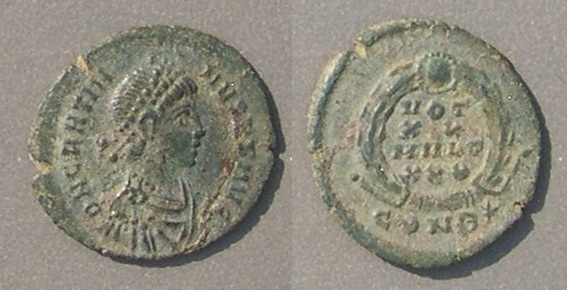 Gratian
Gratian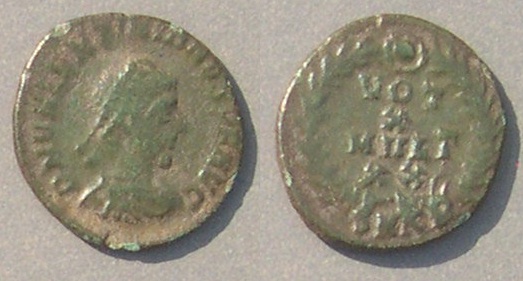 Valentinian II, 375-392
Valentinian II, 375-392This type was also issued for Gratian, Theodosius, and Arcadius.
VOT V MVLT X
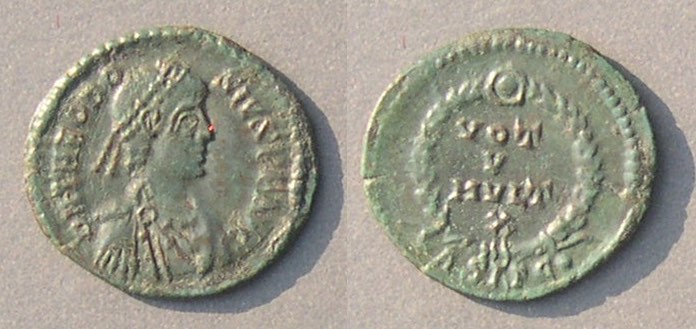 Theodosius, 379-395
Theodosius, 379-395
AE17 (larger than most. Some are 15 mm.)
VOT V MVLT X
ASISC•
RIC Siscia 29d3 "379-383"
RIC puts this type in the same date range as the above types, except its beginning is a little later because Theodosius was not elevated until January 19, 379.
This type was also issued for Gratian, Valentinian II, and Arcadius, as well as very rarely for Magnus Maximus.
VOT V
 Arcadius
Arcadius
14 mm. 0.93 grams.
Note the unbroken obverse legend which indicates a junior emperor, as does the smaller portrait head which the unbroken legend forces.
VOT
V in wreath
CONΓ
RIC Constantinople 62b "19 January 383-25 August 383."
It seems that RIC thinks the death of Valens 25 August 383 caused a new group of types to be issued that no longer included these vota types.
The next coin may simply be a mint error at Antioch. The type belongs to Arcadius and is not issued for Theodosius at Nicomedia, Constantinople, or Heraclea and is r3 at Cyzicus.
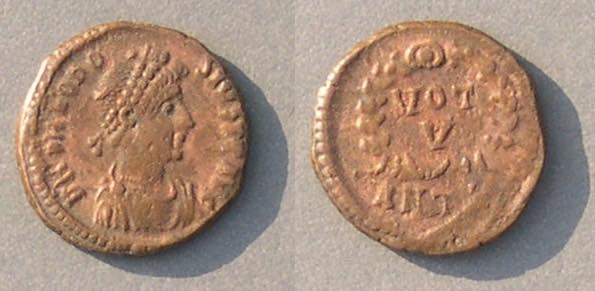 Theodosius
Theodosius
13 mm. 1.56 grams.
VOT
V
ANTA (last "A" weak)
RIC IX Antioch, unlisted for Theodosius, but see 55 for Arcadius.
It is a curiosity.
Another curiosity is this r5 type of Theodosius.
 Theodosius
Theodosius
14-12 mm. 1.31 grams.
VOT
X
MVLT
XXX
This legend has years 10 and 30 instead of 10 and 20 or 20 and 30. The "X" is well-centered and looks intentional.
Mintmark uncertain, but possibly as
RIC Antioch 57 "r5, 378-383", the only mint and issue with this legend.
Note for collectors: Most of the above types are very common and inexpensive. To see more examples from other emperors, go to my site on Late Roman AE coins: http://augustuscoins.com/ed/ricix/
Dating. J. W. E. Pearce, author of RIC IX (Valentinian I - Theodosius I) published in 1933 wrote an article in 1937 explaining the dating of VOTA legends. He argues that VOT V coins could be struck before and during year five as opposed to some others who wrote that their production halted at the beginning of year five. He writes that mintmarks show several types were struck simultaneously, each with reference to a particular emperor's vows, but also each shared, usually in lesser numbers, by the other co-rulers. (There are extremely rare gold coins from Constantinople with legend CONCORDIA GGGG (four G's) that date coins to the time of the period of co-rule, January - August 383 when Valens was still alive and Arcadius not yet elevated.) Look at the dates again:
Gratian (August 367-383) used VOT XV MVLT XX and VOT XX MVLT XXX
Valentinian II (November 375-392) used VOT X MVLT XX
Theodosius (January 379-395) used VOT V MVLT X
Arcadius (January 383-408) used VOT V
He argues that low-numbered vota coins could be (and were) issued anytime from the beginning of the reign through the end of the lower-numbered year, at which time the coins would switch to higher numbering. Only the year 383 from January to August fits all of these which seem to have been issued in the same time interval.* Early 383 could have coins with VOT V for Arcadius at the begining of his reign, in the fifth year of Theodosius (thus still allowing VOT V MVLT X), the eighth year of Valentinian II (allowing VOT X MVLT XX) and the fifteenth year of Gratian (allowing VOT XV MVLT XX).
* As mentioned above, the VOT/XX/MVLT/XXX coins are smaller than the VOT/XV/MVLT/XX coins and its vota numbers are higher, so it is likely to have been issued later in RIC's time interval 378-383.
So, Pearce's article identifies a short time interval in which all the vota dates could have been issued simultaneously, but that does not explain the huge volume of the coinage and if they were issued in that short interval, what was issued the rest of the time? Surely they were issued throughout the reigns and the Arcadius type added in when he was elevated.
 Magnus Maximus
Magnus Maximus
15 mm. 1.85 grams.
VOT/V/MVLT/X
LVGS
RIC Lugdunum 35 "r3" "25 August 383 - 28 August 388"
This issue has the same type as an issue above, but was issued only at Lugdunum and only for Magnus Maximus. The mint did not issue it in the names of the central emperors. For Magnus Maximus this type is very rare.
 Magnus Maximus
Magnus Maximus
14 mm. 1.35 grams.
VO/TIS/V in weath
SCON in exergue
RIC IX Arelate 28 "rare". "383-388"
"The rare AE4 vota coins of the larger module [This type] [were] probably struck at the beginning of Maximus' reign," p. 56. mm PCON or SCON.
Because this is the only issue of this type and it is only from one mint, overall it can be called "very rare."
Valentinian III (425-455) and Theodosius II issued some vota types. They are rare and usually crude and blundered.
 Valentinian III, 425-455. Only for Valentinian III.
Valentinian III, 425-455. Only for Valentinian III. RIC 2140-2141 "AE3/4" for Valentinian III, from Rome, both "S", plate 53 (one photo), p. 379. The above example is clearly "XV".
Note that the RIC photo, with "XV" has a photo where the "V" might almost be an "X" and the type then looks like "VOT / XX".
"[This type] can scarcely be later than about 440." RIC p. 174, which places it in 440-455.
Comment for collectors: If RIC X calls it "scarce" it must be because John Kent saw many poor examples. In my opinion, it is quite rare and examples as nice as this one are very hard to find. I'd call it "very rare." However, AEs from this late period are not highly collected by reverse type and it is not as valuable as its rarity might suggest.

Valentinian III, 425-455. Only for Valentinian III.
13 mm.
VOT/XX in wreath
Q below
13 mm. 1.83 grams. 6:00.
RIC X, 2130 (Rome) "S"
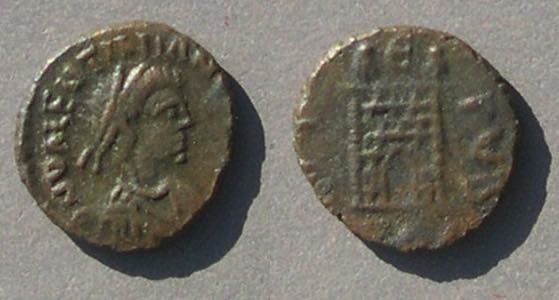 Valentinian III, 425-455. Only for Valentinian III.
Valentinian III, 425-455. Only for Valentinian III.
VOT PVB
around city gate
E above, mm below is possibly RPM
RIC X 2123 Rome, "425-435"
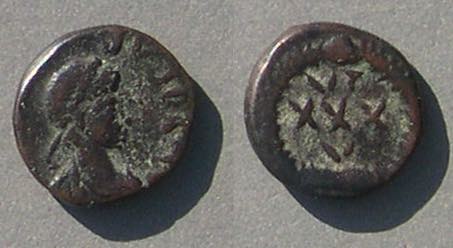 Theodosius II, 402-450. Only for Theodosius II.
Theodosius II, 402-450. Only for Theodosius II.
10 mm. 1.02 grams.
VT/XXX/V
Mintmark off the flan, as usual.
RIC X 457 (Con) C2, 458 (Nic) R2, 459 (Cyz) R4, page 276. Plate 18.457, 458.
Struck 425-435 for the occasion of 435 at Constantinople.
Scholars agree that "35" on this type really does refer to the proper date for vows for 35 years, but in in anticipation.
"May have been followed by a considerable interval in which no bronze was struck." RIC p. 93

DN THEODOSIVS PF AVG, bust right
11 mm. 1.09 grams.
T V/XXX/V (35 years)
in wreath over CON
The example above has "VT" for VOT but this one is blundered to "T V".
RIC X 457, noting it is sometimes "T V". "435" The example on Plate 18 is worse.
Hahn 5th C. 88a (Constantinople) plates 4-5, "435"
Imitations. In the late 4th and 5th centuries small VOTA types were common. Imitations of them are uncommon. Presumably they served as the denomination of contemporary AE4s.
 Uncertain
Uncertain
10 mm. 0.57 grams.
VOT/X/MVLT/XX
 Uncertain
Uncertain Uncertain
Uncertain Uncertain.
Uncertain.
Go to the next page on Byzantine vota coins.
Return to the main vota page (to the coins of Gratian and Theodosius)
Return to the main vota page (to the 5th C. coins)
Return to the top of the main vota page.
Leave the vota pages and go to the Table of Contents for the whole educational site.